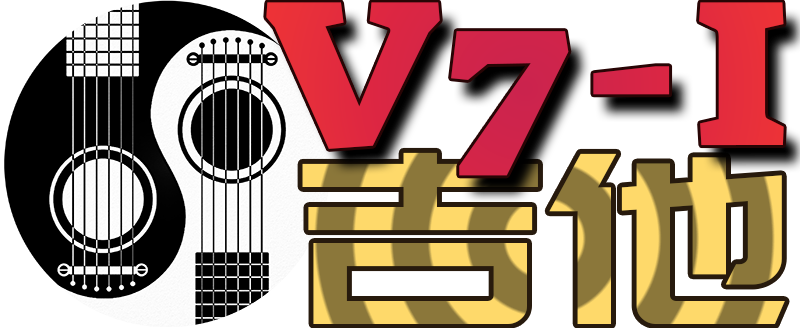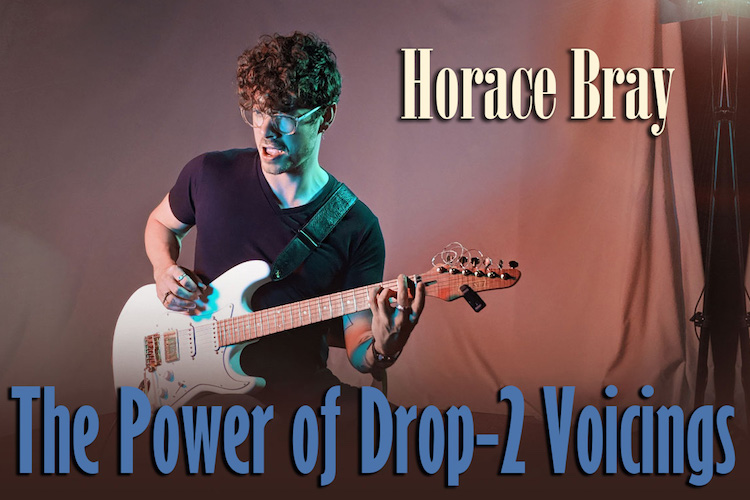时长7小时48分钟。
Lesson 1: Series Introduction
Horace Bray discusses his new series "The Power of Drop 2 Voicings." As an addition to his previous series on triads, this series is all about helping you add color and depth to your playing!
Lesson 2: Major Drop 2 Shapes Part 1 - From the E String
In this lesson, Horace starts us out by explaining exactly what a drop 2 voicing is, and then proceeds to show us our first set of voicings: major shapes from the E string.
Lesson 3: Major Drop 2 Shapes Part 2 - From the A String
Colors of the voices change slightly now, as we move to basing our major drop 2 shapes from the A string.
Lesson 4: Major Drop 2 Shapes Part 3 - From the D String
Now Horace looks at the major drop 2 shapes on the high set of strings - from the D string. As in the first two lessons, we'll play the shapes up and down the neck.
Lesson 5: Minor Drop 2 Shapes Part 1 - From the E String
As you might guess, the drop two voicing can be applied to minor chords also. In this lesson, Horace looks at the low string set for our minor drop 2 shapes.
Lesson 6: Minor Drop 2 Shapes Part 2 - From the A String
Moving to the shapes based from the A string, or middle string set, we find more minor chords with character!
Lesson 7: Minor Drop 2 Shapes Part 3 - From the D String
The high set of drop 2 minor shapes based from the D string evoke a certain type of rhythm guitar, and a wealth of options in your own playing!
Lesson 8: Dominant Drop 2 Shapes Part 1 - From the E String
Dominant chords carry a certain amount of tension with them, and depending on the voicing, that tension can vary a bit. Horace starts us out with these drop 2 shapes based from the E string
Lesson 9: Dominant Drop 2 Shapes Part 2 - From the A String
Now on to the middle set of dominant drop 2 shapes, based from the A string.
Lesson 10: Dominant Drop 2 Shapes Part 3 - From the D String
In this lesson, Horace takes a look at the high string set of dominant drop 2 shapes.
Lesson 11: Half Diminished Drop 2 Shapes Part 1 - From the E String
Learning the best way to use diminished chords can be tricky, but no doubt it starts with learning the shapes inside and out, all up and down the neck. Horace starts us out on the shapes based from the E string.
Lesson 12: Half Diminished Drop 2 Shapes Part 2 - From the A String
Drop 2 shapes are usually out of the ordinary as far as what we are used to playing. The best way of learning these diminished shapes is to take them to the 'woodshed' and get them flawlessly under our fingers. Here, Horace gives us the baseline for practicing these shapes from the A string.
Lesson 13: Half Diminished Drop 2 Shapes Part 3 - From the D String
Now we move the high set of drop 2 diminished shapes, starting from the D string.
Lesson 14: Diatonic Movement - Root Position
In this lesson, Horace shows us how to play the scale diatonically using the root position drop 2 shapes.
Lesson 15: Diatonic Movement - First Inversion
Here, we incorporate the variety and versatility of the drop 2 shapes by playing the diatonic chord scales using first inversion drop 2 shapes.
Lesson 16: Diatonic Movement - Second Inversion
Using second inversion drop shapes, the diatonic chord scales becomes even more colored and diverse!
Lesson 17: Ascending Motion, Descending Harmony
Voice leading allows us to not only keep our voicings close, but to also economize our motion around the neck and fretboard. Horace shows us a tricky but useful exercise where we voice lead our way by ascending our motion while descending our harmony.
Lesson 18: Descending Motion, Ascending Harmony
Now the opposite! We'll descend our motion across the neck, while ascending our harmony. Sort of a brain teaser, but will only help solidify our drop 2 voicings!
Lesson 19: ii-V-I Progressions Part 1 - From the E String
The ii-V-I progression is a cornerstone of jazz, soul/R&B and many other genres. In this lesson, Horace shows us how to incorporate the drop 2 shapes we've learned so far into this classic progression, starting from shapes based from the E string.
Lesson 20: ii-V-I Progressions Part 2 - From the A String
Now on to our ii-V-I drop 2 shapes based from the A string.
Lesson 21: ii-V-I Progressions Part 3 - From the D String
In this lesson we'll look at the high set of strings and how to play our ii-V-I progression.
Lesson 22: Tri-Tone Substitution Overview
What is a tri-tone substitution, why do I need it, and how do I use it? Answers to these and other burning questions can be found in this lesson!
Lesson 23: Minor ii-bv-i Progressions Part 1 - From the E String
Yet another classic progression to practice our drop 2 shapes with. This lesson starts with the shapes based from the E string.
Lesson 24: Minor ii-bv-i Progressions Part 2 - From the A String
Now Horace looks at the middle set of strings for this progression.
Lesson 25: Minor ii-bv-i Progressions Part 3 - From the D String
Lastly, the progression is played on the high set of strings, offering even more colors to play with!
Lesson 26: Neo Soul Drop 2 Licks
Now it's time to apply some of the things we've learned in the series to real life situations. In this lesson, Horace shows us some cool Neo Soul drop 2 licks.
Lesson 27: Diminished Jazz Drop 2 Licks
Diminished drop 2 licks in Jazz can be the basis for great rhythm playing or even chord solos. Horace shows us some great usage for these in this lesson.
Lesson 28: Rock Blues Drop 2 Lick
Although not as common, drop 2 licks can be used in rock and blues. Here Horace shows us a couple of examples of this.
Lesson 29: Drop 2 Etude 1
Now for something a little more challenging. This short Etude can be used to expand your familiarity with drop 2 voicings, and see how they might be used in a song situation.
Lesson 30: Drop 2 Etude 2
Lastly, one more Etude to challenge our knowledge and execution of the drop 2 voicings.
1.如果遇到其他问题可到问答社区进行提问!“进入问答社区”
2.本站非常重视知识产权,如有侵犯任何第三方权益,请及时联系我们,将及时予与删除!“版权协议点此了解”!


 x
x